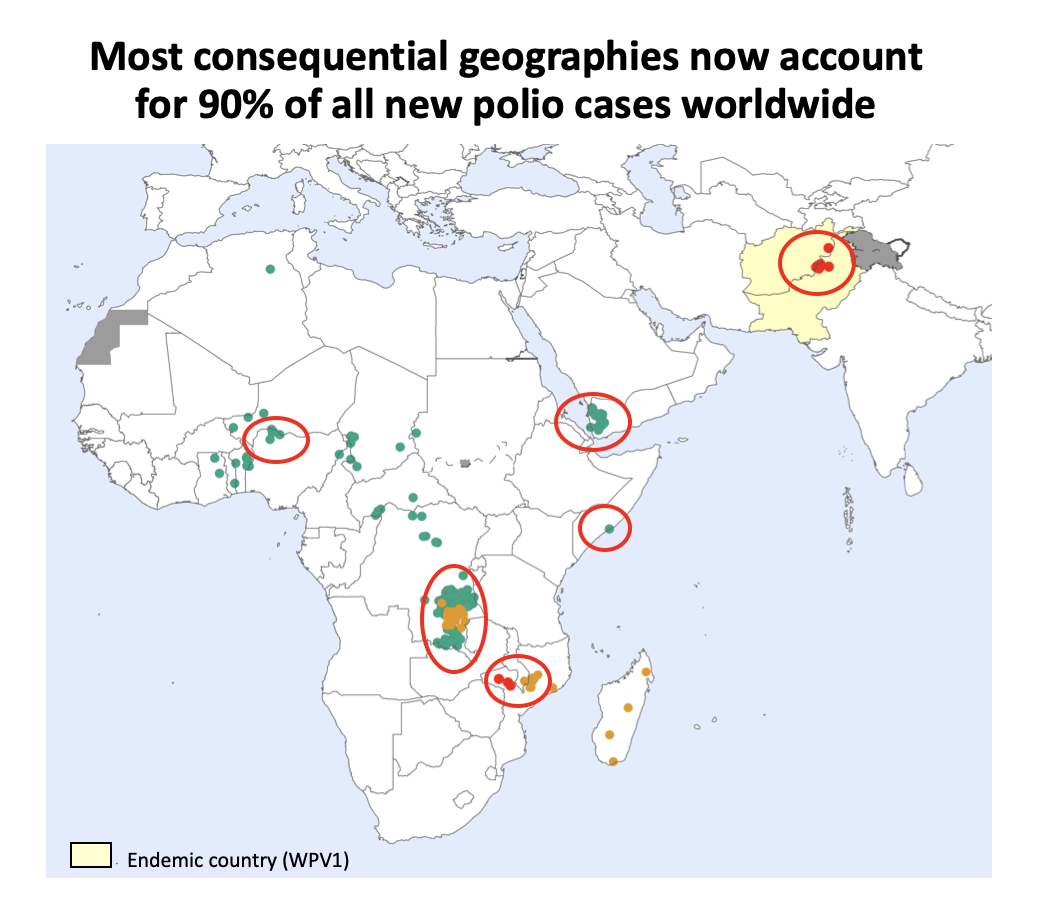
Polio programme must keep clear focus in 2023 on adapting operations amid broader humanitarian emergencies
2023 is a critical year for the global effort to eradicate polio. It is the year where all remaining poliovirus transmission globally is slated to be fully interrupted, per the GPEI Polio Eradication Strategy 2022-2026. A unique epidemiological window of opportunity is presenting itself at the start of the year, that we must capitalize on. So what is the programme’s focus for achieving success this year? The answer is: reaching zero-dose children in the most consequential geographies.......
In the two countries which remaining endemic to wild poliovirus – Pakistan and Afghanistan – virus transmission is more geographically restricted than ever before. In Pakistan, for example, all cases in 2022 were concentrated in just six districts of one province, out of a total of 180 districts in the country. But even more importantly: the biodiversity of the virus (ie the individually-distinct virus lines that actively circulate in the country) continues to decline. In 2020, the country was affected by 11 separate and individual chains of transmission, and this was reduced to four in 2021, and to just one single chain in 2022. This means that individual virus lines are being successfully knocked out. The situation in Afghanistan is very similar, and incidentally, we saw the same thing in other countries as they approached their final eradication efforts, notably India, Nigeria and Egypt.
The virus is at its weakest now, and the opportunity to wiping it out completely is now at its greatest. How do we do this? Very concretely, it means focusing all efforts on the ‘most consequential geographies’. There are the areas which have the greatest impact on the global eradication effort.
But what are most consequential geographies? Put simply, they are seven subnational areas around the world (eastern Afghanistan; southern Khyber Pakhtunkhwa, Pakistan; Tete province and its hinterland in northern Mozambique; eastern Democratic Republic of Congo; northern Yemen; northern Nigeria; south-central Somalia). These areas share certain key programmatic characteristics: they feature some of the highest and most densely-populated proportions of zero-dose children (children who are either un- or under-vaccinated), and they are also affected by broader humanitarian, complex emergencies, including in some areas insecurity, meaning reaching these most marginalized and last-remaining under-vaccinated communities is all the more challenging.

Our overriding programmatic goal must be to adapt our operations to reflect the nature of the complex humanitarian emergencies in each of these seven subnational most consequential geographies. With one single and clear goal: to reach the remaining zero dose children. This means, operating succinctly and effectively within the broader humanitarian context, and that is what we are doing. We work with broader humanitarian partners, we work through a network of coordination such as emergency operations centres, or emergency ‘cells’, to ensure that we deliver polio vaccine, alongside broader interventions, in the most culturally-relevant and appropriate manner.
Polio has in the past year of course re-emerged in places that had been long polio-free. Such events must of course be managed, and are being actively and successfully managed by local public health authorities. But more than anything, such events are a stark reminder of the need to complete the job of global eradication. It is the nature of an eradication effort, of a highly infectious disease which spreads easily with population movements, that such events will continue to occur until polio is gone from all areas. Within that context, it is critical that countries continue with their own national efforts to protect themselves in both the short- and long-term, by continuing to maintain strong disease surveillance and high vaccination coverage, and by fully implementing containment activities.
In conclusion: in 2023, a very real window of opportunity for success presents itself. But this window will not remain open indefinitely for long.
To achieve success now, the focus of all partners and stakeholders must be: reaching zero-dose children in the most consequential geographies. All stakeholders have a role to play in achieving this. We have a collective responsibility. If we keep this focus, success will follow.
For more on consequential geographies, watch this video.
